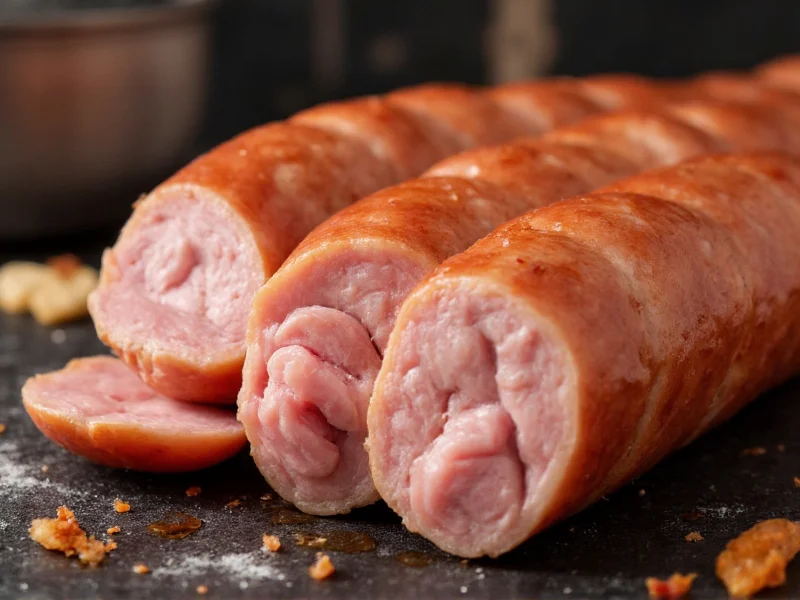The safe internal temperature for pork sausages is 160°F (71°C), as recommended by the USDA Food Safety and Inspection Service. This temperature destroys harmful bacteria like Salmonella and E. coli while maintaining optimal texture and flavor. Always use a food thermometer to verify doneness, as color alone cannot reliably indicate safety.
When cooking pork sausages, achieving the proper internal temperature isn't just about food safety—it's the key to perfectly cooked results every time. Many home cooks make the mistake of relying on visual cues like color or cooking time, but these methods can't guarantee that dangerous bacteria have been eliminated. The USDA has established 160°F (71°C) as the minimum safe temperature for ground pork products because this heat level effectively destroys pathogens that cause foodborne illness.
Why Temperature Matters More Than Appearance
Pork sausages can appear fully cooked—brown on the outside and no longer pink inside—while still remaining at unsafe temperatures. This happens because certain ingredients like nitrites can maintain a pink color even when properly cooked. Conversely, some sausages might brown quickly on the exterior while the interior remains under 160°F. Only a reliable food thermometer provides the accurate measurement needed to ensure safety.
How to Properly Measure Internal Temperature
Correct thermometer placement makes all the difference when checking your pork sausages:
- Insert the probe into the thickest part of the sausage, avoiding contact with the cooking surface
- For links, insert sideways through the middle section
- For patties, insert from the side into the center
- Wait 10-15 seconds for the reading to stabilize
- Check multiple sausages since temperatures can vary
Digital instant-read thermometers provide the most accurate results for thin items like sausages. Dial thermometers often require more time to register and may not be as precise for small food items.
Common Temperature Measurement Mistakes
Even experienced cooks sometimes make these critical errors when checking sausage temperatures:
- Touching bone or pan surface: Creates false high readings
- Checking only one sausage: Temperature varies between items
- Not waiting for stabilization: Reading taken too quickly
- Using damaged equipment: Old or improperly calibrated thermometers
- Removing from heat too early: Temperature continues rising 5-10°F after removal
Recommended Cooking Methods and Temperature Guidelines
| Cooking Method | Recommended Time Range | Target Internal Temperature | Resting Time |
|---|---|---|---|
| Pan-frying | 12-16 minutes | 160°F (71°C) | 3-5 minutes |
| Grilling | 15-20 minutes | 160°F (71°C) | 5 minutes |
| Baking | 20-25 minutes at 375°F | 160°F (71°C) | 5 minutes |
| Smoking | 60-90 minutes at 225°F | 160°F (71°C) | 5-10 minutes |
Remember that cooking times are approximate and should never replace temperature verification. Factors like sausage thickness, starting temperature, and cooking equipment significantly affect how quickly sausages reach 160°F.
Food Safety Considerations for Different Scenarios
For stuffed sausages: When sausages contain additional ingredients like cheese or fruit fillings, ensure the thermometer reaches the sausage meat itself, not just the filling. The meat component must reach 160°F.
When cooking from frozen: Add approximately 50% more cooking time and verify temperature in multiple spots, as frozen centers may not cook evenly.
For food service professionals: Commercial kitchens must follow HACCP guidelines that require documenting temperature checks for pork products. The critical limit for ground pork is 155°F held for 15 seconds, though many establishments use 160°F as a safety buffer.
What to Do If Temperature Is Too Low
If your sausages haven't reached 160°F:
- Return them to the heat source immediately
- Continue cooking in 2-minute increments
- Recheck temperature after each interval
- Avoid pressing sausages, which squeezes out juices and causes dryness
- Consider lowering heat if exterior is browning too quickly
Never serve sausages that haven't reached the safe minimum temperature, even if they appear cooked. Consuming undercooked pork products risks foodborne illness from pathogens like Trichinella spiralis, Salmonella, and E. coli.
Proper Storage of Leftovers
After cooking, handle leftovers safely to prevent bacterial growth:
- Cool cooked sausages within 2 hours of cooking (1 hour if room temperature exceeds 90°F)
- Store in shallow containers to promote rapid cooling
- Refrigerate at 40°F or below for up to 3-4 days
- Freeze for longer storage (2-3 months for best quality)
- Reheat leftovers to 165°F before serving
When reheating, use a food thermometer to verify that leftovers have reached 165°F throughout. This extra step ensures that any bacteria that may have developed during storage are destroyed.
Thermometer Selection and Maintenance
Investing in a quality food thermometer makes a significant difference in food safety:
- Digital instant-read thermometers: Most accurate for thin items like sausages (±1°F accuracy)
- Leave-in probe thermometers: Useful for monitoring temperature during cooking
- Thermocouples: Professional-grade accuracy but more expensive
Calibrate your thermometer monthly using the ice water method (should read 32°F/0°C) or boiling water method (212°F/100°C at sea level). Proper maintenance ensures your temperature readings remain reliable.











 浙公网安备
33010002000092号
浙公网安备
33010002000092号 浙B2-20120091-4
浙B2-20120091-4